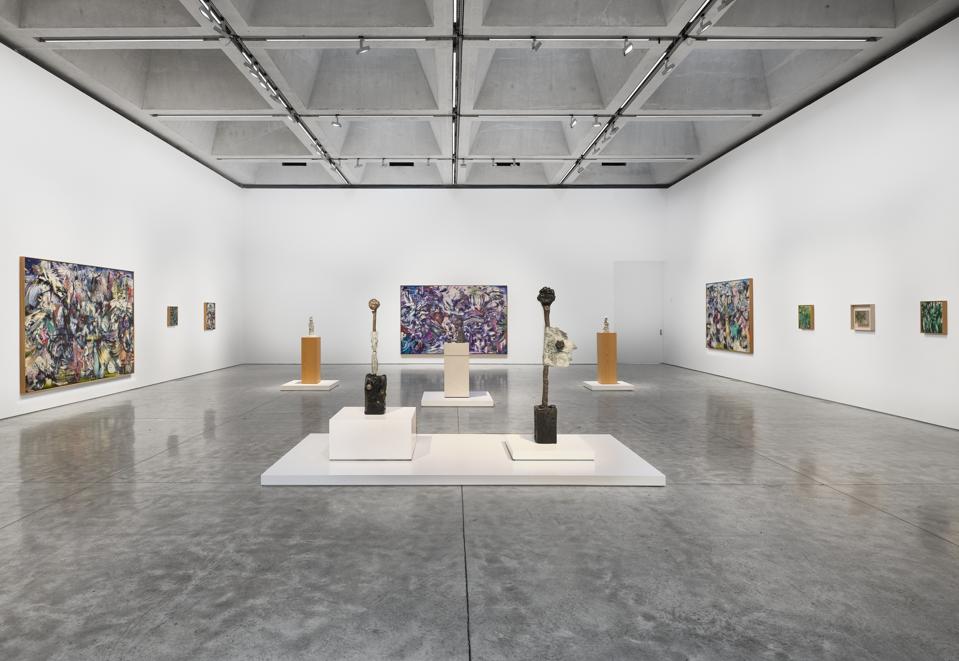Mythical faces and figures emerge and submerge within a massive chaotic convergence of an array of fierce and gestural brushstrokes, the predominantly sumptuous purple canvas drawing the gaze into every colorful crevice. The eye is swept away on a lyrical journey that engages the senses as if all forces and elements of nature are all colliding. Imagine a contemporary inquiry into the Gothic sublime, where attraction and repulsion coexist.
Borrowing from macabre masters such as Francisco Goya, Albert Pinkham Ryder, William Blake, and Edvard Munch, as well as the Surrealist bridge between dream and reality, Ali Banisadr creates a narrative so fresh and raw and rare, the viewer is drawn closer into each beguiling nuance of the complex visual narrative. A multisensory experience captivates the viewer who grapples to untangle the intricate imagery woven into a tour de force of painting.
“As contemporary artists, we live in a storm of images. The speed, saturation, and manipulation of visual culture today functions as a kind of social control—our senses constantly bombarded, our capacity for quiet perception eroded,” says the Iranian-born American contemporary artist. “As a painter, I feel this pressure daily. My studio becomes both a shelter and a decoding space, a place where I can try to make sense of the onslaught.”
Ali Banisadr: Noble/Savage inaugurates the Chelsea, New York, flagship location of Olney Gleason, formerly home to Kasmin. Custom designed by StudioMDA, the gallery includes 7,500 square feet of public exhibition space which allows for a full immersion and exploration of Banisadr’s new paintings, bronze sculptures, and works on paper. Originally opened in 2018, the space, which boasts a rooftop sculpture garden, has hosted nearly 40 exhibitions and installations under the direction of Nicholas Olney, Eric Gleason, and their team at Kasmin.
Born 1976 in Tehran, Iran, Banisadr endured the Iranian Revolution and the Iran-Iraq War before emigrating to the United States at age 12. While visceral sounds of war inform his work, there is a universal quality born from myriad influences that invite both individual and collective consciousnesses to unravel. His experience of synesthesia – perceiving colors as sounds and vice versa – is conveyed to the viewer in a frenzy of elegance.
Banisadr culls from myriad archetypes to illustrate the wrangling of humanity and nature, inserting “O” forms to signify the infinity-looped logo of Meta AI to signal the human dependency on social media. His embrace of color and brushwork traverses art history, hinting at a wide swath of landscape styles, from the expanse and detail of Flemish Renaissance painter Pieter Bruegel, the Elder, to the early work of Jackson Pollock, reflecting his passion for Mexican muralists and his upbringing in Mountain West subregion of the Western United States.
From the immense snake-like or dragon-like aquatic creature with fearsome teeth and impenetrable, tightly sealed scales symbolizing God’s immense power, mentioned in the books of Job, Psalms, and Isaiah, to the hero of the Epic of Gilgamesh, an ancient Mesopotamian narrative poem and the earliest known major work of literature, Banisadr delves deep into mythologies to name his universal visual narratives.
The exhibition title is equally imposing, describing a philosophical concept that idealizes people in a “natural” or “uncivilized” state as embodying innate goodness, purity, and morality, as popularized by Enlightenment philosophers like Jean-Jacques Rousseau, and prominent in Romantic literature. Banisadr’s densely layered work is enriched by his broad scholarship, spanning Palestinian-American academic and literary critic Edward Said, Rousseau, American novelist, playwright, and screenwriter Cormac McCarthy, English novelist, essayist, journalist, and critic George Orwell, and American anthropologist David Graeber.
Banisadr also looks locally for inspiration, using his studio in the forests of New York’s bucolic Hudson Valley, infusing its verdancy into many paintings with a green palette. Building on the complexity of his oeuvre, he perceives the forest as both a force of nature and a site of metamorphosis, further underscoring his Surrealist tendencies.
Noble/Savage presents Banisadr’s bronze sculpture for the first time in a gallery and in New York City, offering a three-dimensional perspective of the same themes. These woks cast from natural materials are simultaneously primordial and futuristic, amplifying the viewer’s multisensory voyage across centuries and cultures.
Rather than be intimidated by the scope and depth of Banisadr’s far-reaching references, enjoy its dark beauty and let your own biological and figurative vision, and possibly the sounds that arise, guide your gaze.

